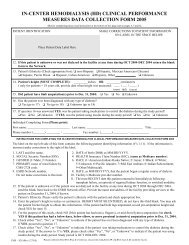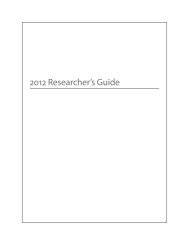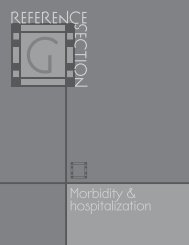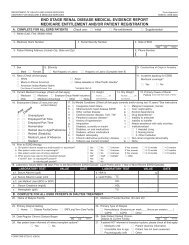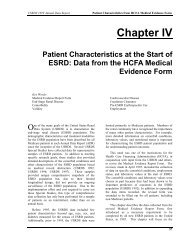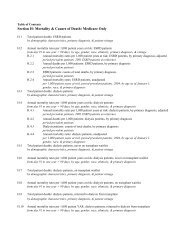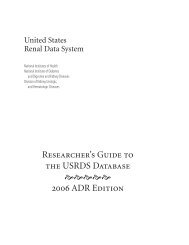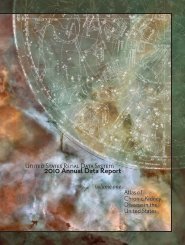2009 ADR v2 Atlas of ESRD - United States Renal Data System
2009 ADR v2 Atlas of ESRD - United States Renal Data System
2009 ADR v2 Atlas of ESRD - United States Renal Data System
You also want an ePaper? Increase the reach of your titles
YUMPU automatically turns print PDFs into web optimized ePapers that Google loves.
5<br />
App A<br />
pg 360<br />
<strong>ESRD</strong> PATIENT DETERMINATION<br />
A person is identified as having <strong>ESRD</strong> when a physician certifies<br />
the disease on the CMS ME form, or when there is other evidence <strong>of</strong><br />
chronic dialysis or a kidney transplant. Patients with acute kidney<br />
failure who are on dialysis for days or weeks, but who then recover<br />
kidney function, are excluded from the database if their ME forms<br />
have not been submitted. Patients who die soon after kidney failure<br />
without receiving dialysis are sometimes missed.<br />
The <strong>ESRD</strong> First Service Date (FSD) is the single most important<br />
data element in the USRDS database, and each patient must, at a minimum,<br />
have a valid FSD. This date is used to determine the incident<br />
year <strong>of</strong> each new patient and the first year in which the patient is<br />
counted as prevalent. The date 90 days after the FSD is used as the<br />
starting point for most survival analyses.<br />
The FSD is derived by taking the earliest <strong>of</strong> the date <strong>of</strong> the start<br />
<strong>of</strong> dialysis for chronic kidney failure, as reported on the ME form;<br />
the date <strong>of</strong> a kidney transplant, as reported on a CMS or OPTN transplant<br />
form, an ME form, or a hospital inpatient claim; or the date <strong>of</strong><br />
the first Medicare dialysis claim. Most FSDs are obtained from the<br />
ME form. In the absence <strong>of</strong> this form, the date <strong>of</strong> the first Medicare<br />
dialysis claim or transplant usually supplies the FSD. In the few<br />
cases in which the date <strong>of</strong> the earliest dialysis claim precedes the<br />
first dialysis date reported on the ME form, the earliest claim date<br />
is used as the FSD. However, starting with the 2007 <strong>ADR</strong>, a patient<br />
entering into the <strong>ESRD</strong> program after December 31, 1994 will have<br />
his or her FSD defined solely by the regular dialysis start date or the<br />
preemptive transplant date, whichever is earliest, on the ME form.<br />
This new method <strong>of</strong> determining the FSD has been introduced so<br />
as to align more closely to the methods used by CMS. After years <strong>of</strong><br />
careful monitoring and repeated comparative analyses <strong>of</strong> the traditional<br />
USRDS method to the new ME method, the USRDS hasbegun<br />
applying the ME method to incident patients entering into the <strong>ESRD</strong><br />
program on or after January 1, 1995.<br />
MEDICARE & NON-MEDICARE (‘ZZ’) PATIENTS<br />
Beneficiaries are enrolled in Medicare based on criteria defined<br />
in Title XVIII <strong>of</strong> the Social Security Act <strong>of</strong> 1965, and in subsequent<br />
amendments to the act. A person in one <strong>of</strong> these four categories is<br />
eligible to apply for Medicare: age 65 and over, disabled, <strong>ESRD</strong> program,<br />
and Railroad Retirement Board (RRB).<br />
Most <strong>ESRD</strong> patients are eligible to apply for Medicare as their<br />
primary insurance payor. Some, however, are not immediately eligible<br />
for Medicare coverage because <strong>of</strong> their employment status and<br />
insurance benefits. These patients are usually covered by employer<br />
group health plans (EGHPs), and must wait 30–33 months before<br />
becoming eligible to have Medicare as their primary payor. Some <strong>of</strong><br />
these patients, particularly new patients since 1995, have FSDs established<br />
by ME forms, but have no dialysis claims or hospitalization<br />
events in the CMS claims database. In the REBUS/PMMIS database all<br />
non-Medicare <strong>ESRD</strong> patients are assigned a code <strong>of</strong> ‘ZZ’ in the twocharacter<br />
Beneficiary Identification Code field. CMS does not generally<br />
include these patients in the datasets released to researchers.<br />
The USRDS recognizes that ‘ZZ’ patients are true <strong>ESRD</strong> patients,<br />
and should be included in patient counts for incidence, prevalence,<br />
and modality. Calculations <strong>of</strong> standardized mortality ratios, standardized<br />
hospitalization ratios, and standardized transplantation<br />
ratios, however, should not include these patients because <strong>of</strong> the<br />
small number <strong>of</strong> claims available in the first 30–33 months after<br />
their first <strong>ESRD</strong> service. Furthermore, it may not be possible to link<br />
‘ZZ’ patients to their <strong>ESRD</strong> Death Notification forms or the OPTN<br />
transplant data, or to determine comorbidity or inpatient/outpa-<br />
tient and physician/supplier services. Because such data are limited,<br />
event rates that include these patients must be assessed with caution.<br />
We continue to include ‘ZZ’ patients in the mortality rate calculations<br />
<strong>of</strong> the <strong>ADR</strong>. We are collaborating with CMS and other interested<br />
researchers to establish a consistent approach to managing the<br />
data for these patients. The USRDS, in working with CMS, has been<br />
able to resolve most <strong>of</strong> the ‘ZZ’ patients since the release <strong>of</strong> the <strong>ESRD</strong><br />
Patient <strong>Data</strong>base, REMIS, in the fall <strong>of</strong> 2003. According to our most<br />
recent assessment — performed during the production <strong>of</strong> the 2007<br />
<strong>ADR</strong> — we have determined that at least 99 percent <strong>of</strong> ‘ZZ’ patients<br />
have been resolved due to significant advancements in the REMIS/<br />
REBUS database system.<br />
LOST-TO-FOLLOW-UP METHODOLOGY<br />
The USRDS uses all available data to create a treatment history for<br />
each patient in the database, including all modality events, their<br />
duration, and the renal providers involved in each patient’s care.<br />
Gaps frequently exist in the billing data upon which modality<br />
periods are based. The USRDS assumes that a modality continues<br />
until death or the next modality-determining event. A patient with<br />
a functioning transplant is assumed to maintain it unless a transplant<br />
failure or death notification is encountered in the data. In the<br />
absence <strong>of</strong> a death notification, dialysis claims, or other confirmation<br />
<strong>of</strong> a continuing modality, a dialysis modality, in contrast, is<br />
assumed to continue for only 365 days from the date <strong>of</strong> the last claim.<br />
After this period the patient is declared lost-to-follow-up until the<br />
occurrence <strong>of</strong> a dialysis claim or transplant event.<br />
Because Medicare may be the secondary payor for up to the first<br />
30–33 months <strong>of</strong> <strong>ESRD</strong>, delaying the submission <strong>of</strong> Medicare dialysis<br />
claims, lost-to-follow-up categorization cannot begin until the end<br />
<strong>of</strong> the third year after the start <strong>of</strong> <strong>ESRD</strong> service. This “first three-year<br />
rule” is particularly important for non-Medicare patients, who may<br />
be followed for up to three years with limited event or mortality<br />
data. These patients would contribute dialysis or transplant days to<br />
the denominator <strong>of</strong> rate calculations, but only questionable event<br />
data to the numerator. In comparison to the two-year rule used in<br />
the 2001 <strong>ADR</strong>, this three-year rule significantly reduces the number<br />
<strong>of</strong> lost-to-follow-up patients in the prevalent population.<br />
A number <strong>of</strong> events can result in a lack <strong>of</strong> dialysis data and eventual<br />
reclassification <strong>of</strong> a patient as lost-to-follow-up:<br />
4 The patient may have recovered renal function (RRF) and no<br />
longer have <strong>ESRD</strong>. For a valid patient classification, this event<br />
must occur within 180 days <strong>of</strong> the FSD, and the RRF period<br />
must persist for at least 90 days.<br />
4 The patient may have left the country.<br />
4 The patient may receive dialysis covered by a payor other<br />
than Medicare, or have received a transplant not paid for<br />
by Medicare or reported to OPTN.<br />
4 The patient may be enrolled in a Medicare HMO, so that Medicare<br />
dialysis claims are not generated even though the patient<br />
is eligible for Medicare coverage.<br />
4 The patient’s death may not have been reported to the Social<br />
Security Administration or to CMS.<br />
INTEGRATION OF THE USRDS, SIMS, & REMIS DATABASES<br />
We have worked to reconcile <strong>ESRD</strong> patients in the SIMS, REMIS, and<br />
USRDS databases. We have analyzed each database for duplicate<br />
records, consolidated these records, and integrated the databases.<br />
<strong>Data</strong> were then re-analyzed for duplicates, which were themselves<br />
consolidated. This consolidation <strong>of</strong> patients is an ongoing collaborative<br />
effort between the <strong>ESRD</strong> Networks, CMS, and the USRDS.




